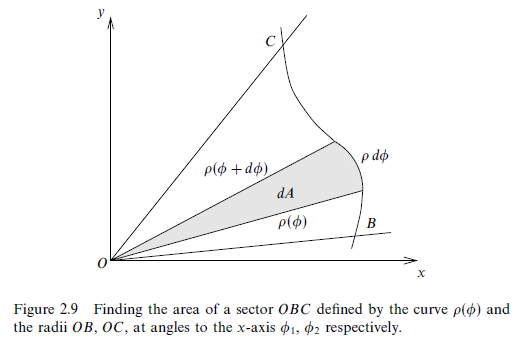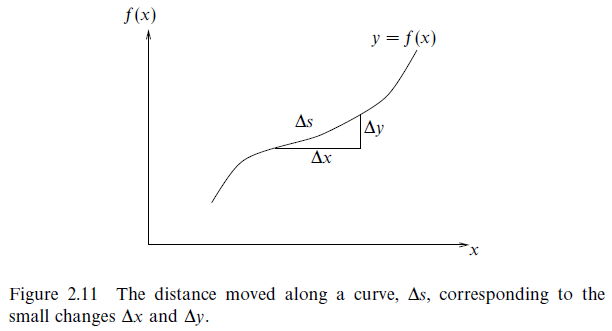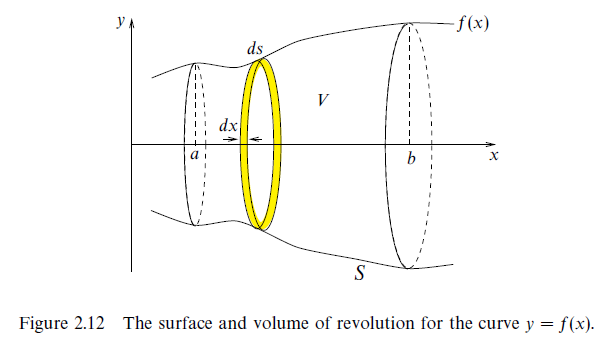Mathematical Methods for Physics and Engineering
1. Basic derivatives of some functions [Page 44]
2. Some properties of curves [Page 44,49,51,53-56]
\frac{df}{dx}=0,\frac{d^2f}{dx^2}>0\Rightarrow Minimum;\frac{df}{dx}=0,\frac{d^2f}{dx^2}<0\Rightarrow Maximum .
\frac{df}{dx}=0,\frac{d^2f}{dx^2}=0\Rightarrow a\ stationary\ point\ of\ inflection\\(\frac{d^2f}{dx^2} changes sign through the point, normally requires \frac{d^3f}{dx^3}\neq0).
For a curve s(x), \frac{ds}{dx}=[1+(\frac{df}{dx})^2]^{1/2}.
The radius of curvature: \rho=\lim\limits_{\Delta\theta\rightarrow0}\frac{\Delta s}{\Delta\theta}=\frac{ds}{d\theta}=\frac{ds}{dx}\frac{dx}{d\theta}=\frac{[1+(f{'})^2]^{3/2}}{f{''}} and \rho=\frac{(a^4y^2+b^4x^2)^{3/2}}{a^4b^4} for \frac{x^2}{a^2}+\frac{y^2}{b^2}=1.
Rolle’s theorem: if a function f(x) is continuous and differentiable in the range (a,c), and satisfies f(a)=f(c), then for at least one point x = b, where b\in(a,c),f'(b) = 0.
Mean value theorem: if a function f(x) is continuous and differentiable in the range (a,c) then f'(b)=\frac{f(c)-f(a)}{c-a} for at least one value b where b\in(a,c).
3. Basic integrals of some functions [Page 63]
4. Methods and properties of integrations [Page 63-70,72-73]
Sinusoidal functions: sin^2x = 1−cos^2x for odd degree of sinusoidal functions; cos^2x=\frac{1 + cos2x}{2} for even degree of sinusoidal functions. [p63]
Sometimes you can find: \int \frac{f'(x)}{f(x)}dx=lnf(x)+c. [p64]
Using partial fractions (see ch1-preliminary calculus sections 6,7 and 8).
Integration by substitution: x = sinu or tan\frac{x}{2}=t (see ch1-preliminary calculus section 4), etc.
Integration by parts: \int u\frac{dv}{dx}dx=uv-\int v\frac{du}{dx}dx. [p67-69]
Reduction formula: find relations between I_n and I_{n-1}, and then find I_0 to finally find I_n. [p69]
Deal with infinite and improper integrals: exclusion. For example, if the integrand f(x) is infinite
at x = c,c \in [a,b] then \int_{a}^{b}f(x)dx=\lim\limits_{\delta\rightarrow0}\int_{a}^{c-\delta}f(x)dx+\lim\limits_{\epsilon \rightarrow0}\int_{c+\epsilon}^{b}f(x)dx.
Evaluation of an integral: If \phi_1(x)<f(x)<\phi_2(x),x\in[a,b], then \int_a^b\phi_1(x)dx<\int_a^bf(x)dx<\int_a^b\phi_2(x)dx. [p72]
Mean value of a function: m=\frac{1}{b-a}\int_a^bf(x)dx. [p72-73]
5. Some integrals of curves, area and volume [Page 63-70]
Area in plane polar coordinates [p71]:

Length of a curve in x-y coordinates and plane polar coordinates [p73]:

Surfaces of revolution [p74-75]:
Rotate about x-axis:

Rotate about y-axis:
Volumes of revolution [p75-76]:
Rotate about x-axis:
Rotate about y-axis:

Comment Section